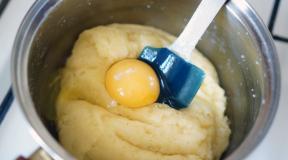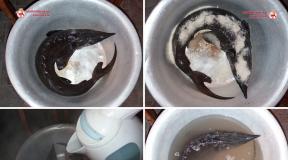How to make moonshine from copper on your own. Alambik copper moonshine How to connect the coil
Preparation of moonshine and alcohol for personal use
absolutely legal!
After the demise of the USSR, the new government stopped the fight against moonshine. Criminal liability and fines were abolished, and an article prohibiting the production of alcohol-containing products at home was removed from the Criminal Code of the Russian Federation. To this day, there is not a single law that prohibits you and me from engaging in our favorite hobby - making alcohol at home. This is evidenced by the Federal Law of July 8, 1999 No. 143-FZ "On the administrative responsibility of legal entities (organizations) and individual entrepreneurs for offenses in the field of production and circulation of ethyl alcohol, alcoholic and alcohol-containing products" (Collected Legislation of the Russian Federation, 1999, No. 28 , item 3476).
Excerpt from the Federal Law of the Russian Federation:
"The effect of this Federal Law does not apply to the activities of citizens (individuals) who do not produce products containing ethyl alcohol for the purpose of marketing."
Moonshine in other countries:
In Kazakhstan in accordance with the Code of the Republic of Kazakhstan On Administrative Offenses dated January 30, 2001 N 155, the following liability is provided. Thus, according to article 335 “Manufacture and sale of home-made alcoholic beverages”, illegal production for the purpose of selling moonshine, chacha, mulberry vodka, mash and other alcoholic beverages, as well as the sale of these alcoholic beverages, entails a fine in the amount of thirty monthly calculation indices with confiscation of alcoholic beverages , apparatus, raw materials and equipment for their manufacture, as well as money and other valuables received from their sale. However, the law does not prohibit the preparation of alcohol for personal purposes.
In Ukraine and Belarus things are different. Articles No. 176 and No. 177 of the Code of Administrative Offenses of Ukraine provide for the imposition of fines in the amount of three to ten tax-free minimum wages for the manufacture and storage of moonshine without the purpose of sale, for the storage without the purpose of sale of apparatus * for its production.
Article 12.43 repeats this information practically word for word. “Production or purchase of strong alcoholic beverages (moonshine), semi-finished products for their production (mash), storage of devices for their production” in the Code of the Republic of Belarus on Administrative Offenses. Paragraph No. 1 states: “Manufacturing by individuals of strong alcoholic beverages (moonshine), semi-finished products for their manufacture (mash), as well as storage of devices * used for their manufacture - entails a warning or a fine in the amount of up to five basic units with confiscation of the indicated drinks, semi-finished products and devices.
* It is still possible to purchase moonshine stills for home use, since their second purpose is to distill water and obtain components for natural cosmetics and perfumes.
Traditionally, in our country, alcoholic beverages are made at home using moonshine. However, not so long ago, very interesting products appeared on sale, which are also excellent for this purpose. They are made of copper and are called alambiks. In this regard, many fans of the distillation of homemade alcoholic beverages have a question: "Alambik or moonshine - which is better?"
Features of the design of the moonshine still
The classical equipment for the distillation of alcohol used in Russia consists of:
A distillation cube in which raw materials are heated.
Sealed lid with thermometer.
Steam tube.
Coil tubes.
Refrigerator filled with water. A coil passes through this container.
Containers for collecting the final product.
Sometimes the apparatus is supplemented with a distillation column. With its use, you can get very clean moonshine, devoid of any smell. As a filler in a distillation column, metal shavings are usually used. Heavy fractions of steam settle in this device.
Alambika design features
So, alambik or moonshine - which is better? To answer this question for yourself, you should also learn about the design features of the copper version. In fact, alambic is the same distillation cube. The design of the classic model includes:
distillation cube;
a helmet in the form of an onion;
steam tube;
coil in the refrigerator.
As you can see, structurally, the alambik is practically no different from the moonshine still. Often, in addition to it, a special column is purchased, installed between the helmet and the alembic. Unlike distillation, it is used to give moonshine a certain smell and taste. For this, various natural ingredients are poured into it. Alambik with a column can be used not only for making moonshine, but also for obtaining essential oils. This is how in ancient times they used alambik (or moonshine for an alchemist). They learned how to get alcohol with its use a little later.

Essential oils are prepared in alambika using a rather simple technology. It is not mash, but water that is poured into the distillation tank. At the same time, flower petals are poured into the column, for example. Passing inside it, the steam simply captures aromatic compounds. Very often, alambicas are also used to make cognacs and other expensive alcoholic beverages.
Types of alambiks
The model described above is the classic, most popular alambik moonshine still. Its device is really simple. However, today on sale you can find slightly different varieties of this equipment. Alambikas exist:
Designed for the production of whiskey. A feature of such devices is a helmet made in the form of an onion. With their use, you can drive moonshine with a strength of up to 70 gr.
Charente. Used to distill cognac. A special container is additionally included in the design of this apparatus. With the use of such alambicas, almost continuous distillation can be carried out.
There are also alambiks with distillation columns, water seals, in a water bath, etc.
Alambik or moonshine - which is better in this or that case?
What is the best device to buy for making alcoholic beverages at home? In this case, it all depends on the purpose for which it is supposed to use the device.

Since alambiks are made of copper, their price is much higher than for conventional moonshine stills. The first type of distillation devices costs about 12-25 thousand rubles. can be purchased for 3-10 thousand. Thus, the high cost can be attributed to the minuses of alambiks. Their advantage is that:
Moonshine expelled with their use is better. The copper from which they are made absorbs many harmful substances during the distillation process. In addition, even in the absence of a column, some of them settle in the helmet.
With the use of alambik, you can cook not only moonshine, but also liquors, wine, etc.
Thus, in the event that you only need the unit for making moonshine, it is better to purchase an inexpensive regular stainless steel model. But at the same time, you should definitely pay attention to the quality of the material used for manufacturing. Stainless steel should be food, and even better, medical. With the use of such moonshine stills, it is possible to drive a drink, in quality inferior to that made with the help of alambic, only slightly.
If it is supposed to make not only moonshine, but also other, more complex drinks, of course, you should pay attention to alambic (or

The best models of moonshine stills and reviews about them
Most often in our country they buy equipment of this type of brand:
"Magarych".
Gorilych.
Judging by customer reviews, using the latter, you can drive a very good moonshine, almost devoid of any smell. Also, the advantages of "Gorilychi" include ease of use and low cost.
Apparatus "Magarych" lovers of distillation of homemade alcoholic beverages are also considered very reliable. The advantage of these models is also considered excellent build quality and attractive appearance. Such a device can serve for a very long time, as it is made of thick steel. The simplicity of design and the absence of unnecessary details are also considered by many to be a plus for models of this brand.

Alambik moonshine still: consumer reviews
The best equipment of this type is considered to be made in Portugal and Spain. It is about these models that there are the most good reviews. Alambiques are usually made by hand in these countries and are not cheap. Their assembly is carried out according to technologies developed in ancient times. Copper for the manufacture of such alambiks is used only the highest quality. Enterprises specializing in its production carefully monitor this.

Too inexpensive devices of this variety, many consumers are not advised to purchase. The fact is that often these are ordinary fakes made of stainless steel, only decorated with copper. Consequently, the moonshine expelled in them is absolutely no different from that prepared in a traditional apparatus.
Where can I buy?
Many users are interested in where you can buy such an interesting moonshine still. Barrels and alambicas, as well as ordinary stainless steel models, are often sold in specialized departments of household appliances shopping centers. This equipment can also be purchased online. A barrel should be bought for storage, for example, cognac made with the help of alambic.
Is it possible to make an alambic with your own hands
To make such a device yourself is not too simple. However, with a strong desire, everything is possible. Sheet copper and a minimum of skills in soldering it are all that is needed to assemble equipment such as an alambik moonshine with your own hands. Reviews about equipment of this type made by Russian craftsmen are often no worse than about Portuguese and Italian ones. But only if high-quality material and expensive solder with the addition of silver were used during its assembly. The very same technology for making alambic looks like this:
Cutting is done beforehand. Of course, it will be problematic to make a spherical distillation vessel. But it is quite possible to give it a cylindrical shape with a smoothed contour of the top and bottom.
Soldering is in progress.
The finished device is cleaned to a shine.

Thus, asking the question: “Alambik or moonshine - which is better?”, You should first of all be guided by the purpose for which the equipment is required. The first variety is worth buying for those who want to try their hand at making different types of alcoholic beverages. If you need ordinary moonshine, it is still better to purchase a simple stainless steel model.
Skilled craftsmen make moonshine with their own hands. Thanks to this, they not only save money, but also get a high-quality and reliable device for preparing alcohol. Moonshine is a traditional strong drink, and is highly valued for its strength and taste. Some use it in its pure form, while others prepare tinctures, liqueurs or cognac.
The history of the moonshine still
The first mention of moonshine dates back to the 4th century AD. e. - one Chinese alchemist described a clear drink distilled several times. According to historical data, the distillation technology was used by both the Romans and the Greeks and Egyptians.
The apparatuses were mostly made of stone. After a while, the Arabs invented a device already made of copper. Thanks to him, the liquid was heated evenly, and harmful oils were completely removed.
Further development of moonshine stills:
- 9th century - the invention of the serpentine by the Persians - a copper pipe bent into several turns, which is cooled in air;
- X century - moonshine is gaining popularity, on its basis, recipes for elixirs and potions are developed;
- XV century - the coil is lowered into cold water to increase the amount of alcohol condensate.
The improved invention served as a prototype of a modern apparatus containing: a distillation cube, a refrigerator, a steamer.
The moonshine still (distiller) is quite simple. Its constituent parts:
- Distillation cube (evaporator). It is used for heating primary raw materials - mash, alcohol with impurities or low-quality wine.
- The distillation cube can be made independently of the required size or use improvised containers:
- pots;
- cans;
- flasks;
- various flasks.
- Refrigerator (condenser). Thanks to this detail, the condensation of alcohol vapor occurs. The condenser must be constantly cooled, because alcohol vapors during condensation heat its surface.
- Pipeline (coil). With the help of this part, alcohol vapors from the evaporator enter the refrigerator. For the coil, a tube is taken, bent in the form of a spiral.
- copper;
- glass;
- stainless steel.

There are more advanced designs, which additionally include:
- Sukhoparnik (reflux condenser) - primary filter for cleaning. In most cases, it is installed at the point where the coil enters the evaporator. Harmful steam, passing through the dryer, condenses here, and no longer evaporates back.
- Bubbler. This element is designed to improve the quality of moonshine. He, like the dryer, plays the role of a filter. Only the bubbler tube, unlike the tube of the dryer, is pre-filled with liquid and in the primary raw material in the evaporator reaches the very bottom. To give moonshine a specific taste, flavorings, such as lemon peels, are added to the liquid.
- Wood or carbon filters, thermometers, temperature sensors.
The result of the work of the moonshine still is the production of an alcoholic beverage, which does not contain impurities harmful to humans that spoil the taste. The share of ethyl alcohol in the finished product is on average 60-70%.
 The main stages of the distiller:
The main stages of the distiller:
- Braga is heated to the required temperature (83 - 93ºС), while alcohol vapors begin to be released.
- Alcohol vapors through a special tube enter the coil.
- The vapors are cooled and sit on the walls of the coil in the form of condensate.
- As a result, moonshine begins to drip from the tube.
Important! The first received 50 - 100 gr. moonshine contain toxic impurities: fusel oils, methanol and others, so they must be drained. To improve the quality of the product, the resulting moonshine is filtered with activated carbon and potassium permanganate, and then re-distilled.
Having made a home-made moonshine still at home with your own hands, you yourself will be responsible for the quality of the resulting drink.
Making a moonshine still
Making a moonshine still with your own hands is quite simple, guided by ready-made drawings, diagrams or drawings. The manufacture of moonshine still consists of several stages. To begin with, collect its individual elements.

Tubes made of stainless steel, copper, aluminum or silicone hoses (medical or food) are used as connecting elements. Stainless steel tubing is the easiest, most economical and safest option.
To connect different elements of the pipeline, branching turns, transitions from one diameter to another, fittings and fittings (bronze, brass or stainless steel) are used. Cold welding or hot melt adhesive is suitable for sealing, rubber gaskets are not recommended.

A distillation cube can serve:
- Multicooker (or pressure cooker). Almost finished sealed container. The only thing that needs to be done is a hole in the lid for a tube through which steam will escape. The convenience is that the heating is carried out at the set temperature. The disadvantage is the small size.
- Milk can (aluminum or stainless steel). The most practical option. It is only necessary to get rid of the rubber gaskets on the lid. Rubber contains harmful substances that adversely affect the smell and taste of moonshine. Therefore, we replace the old gaskets with silicone ones.
- Enameled bowl. The evaporator from it is quite simple to manufacture, the only difficulty is sealing the lid.
 The container must be prepared for use:
The container must be prepared for use:
- The rubber seal is removed.
- Silicone sealant is applied around the circumference of the lid. After it dries, the action is repeated (up to 3 times).
- A hole of the required size is made in the lid to install a tube connecting the future distillation cube and the coil (or dry steamer).
Important! In order for the milk can vaporizer to last for a long time, it must be washed with soap and plenty of water after each use. In no case do not use soda and cleaning powders for these purposes.
The capacitor includes 2 elements:
- coil (twisted tube);
- tank for cooling the coil.
The capacity for cooling the coil is the most important part of the entire apparatus, the quality and volume of the resulting moonshine depends on it.

As a material suitable:
- Copper. It has the highest thermal conductivity and ease of processing (can be soldered). To maintain the quality of the produced moonshine, the copper coil must be thoroughly cleaned of plaque obtained due to oxidation with alcohol (preferably every time after distillation). This is done with citric acid and boiling water or with vinegar. Although copper, slightly oxidized with alcohol, improves the taste of moonshine.
- Aluminum. Less thermally conductive than copper, but cheap, readily available, and easy to work with. True, aluminum coils are not particularly common. do not add taste to moonshine.
- Stainless steel. Does not oxidize and does not interact with alcohol. The material is quite difficult to process.
- Glass. It is simply impossible to make a glass coil at home without special equipment. Better - buy a finished item in the store. Glass has low thermal conductivity and is very brittle.
Choosing the thickness and size of the coil tube
- Length - from 1.5 to 2 meters. The area of contact between the steam and the cooling element depends on it, but too long a tube will reduce the speed of the distillation.
- The inner diameter is from 8 to 12 mm. The cooling efficiency depends on it (the larger the diameter, the faster the cooling occurs). True, tubes of large diameters are difficult to process.
- Thickness - from 0.9 to 1.1 mm. The thermal conductivity depends on it (the smaller the thickness, the higher the thermal conductivity and the better the condensation of alcohol vapor). True, thin tubes are very brittle.
The efficiency of its work depends on the choice of the correct parameters of the coil tube.
Coil connection method
Usually the coil is located vertically. In this case, moonshine, condensed on the walls, runs by gravity and does not slow down the movement of steam. To reduce resistance, steam is directed to the top of the coil.
 It could be:
It could be:
- water;
- air;
The most common is water cooling.
Choosing a heat dissipation scheme
She happens:
- open (operate on circulating water);
- closed (water does not circulate, but stands in a container, for example, in a bucket).
It is more profitable and easier to assemble a closed system, but the coil cools more slowly with this scheme. This leads to a deterioration in the quality of moonshine and its losses.
It is more difficult to assemble a flow system, a large volume of water is required, but the distillate is of high quality.
To save money, you can create a circulation of a certain volume of water, but this is quite energy-intensive. For a flow circuit, a small capacity is suitable.
Water should enter the refrigerator from the bottom and exit from the top. This contributes to the rapid cooling of the coil from below.

You will need a tube made of aluminum, copper or stainless steel. As a container for cooling, we take a metal or plastic pipe (diameter - from 75 to 80 mm). In the figure you can see the drawing of the refrigerator.
The main stages of production:
- The coil tube is stuffed with sand or soda so that it does not flatten during curling. The ends of the tube are clogged with chopsticks. It is recommended to weld the nut on one side.
- The tube is wound around a cylindrical object, having a smooth section of the required diameter. It is recommended to make a gap between the turns - 12 mm
- The ends of the made coil are released. The tube is cleaned and rinsed with running water. Pipes for water circulation are installed.
- The coil is placed inside the housing, and plugs are installed on both sides. All joints are sealed.

With high-quality manufacturing of the capacitor, the moonshine obtained at the final stage will be room tº or cold.
The sukhoparnik and bubbler perform the same task, differing only in some design details.
Sukhoparnik - a sealed metal or glass tank between the evaporator and condenser. The vapors in it are cooled, and then the liquid boils again, and enters the coil.
A bubbler is a device similar to a steamer, but alcohol vapor is passed through water (or other liquid). The tube through which steam is supplied sinks almost to the bottom.
 The purpose of the steamer (bubbler):
The purpose of the steamer (bubbler):
- Prevents mash from getting into the final product.
- Aromatizes alcohol during distillation (for this, pieces of apple, citrus peels are placed in a container).
- Purifies the distillate from some of the harmful oils.
- Makes the drink stronger.
Installing a large number of dry steamers (bubblers) will not make moonshine super clean, but will only increase its strength. All the harmful substances that the dry steamer (bubbler) cleans from are in the first can, and the subsequent ones remove only water from the distillate.
The main stages of production:
- Necessary materials:
- sealed container, for example, a glass jar (its volume should be 10 times less than the volume of the evaporator);
- fitting - 2 pcs.;
- nut - 2 pcs.;
- awl;
- hot melt or cold welding;
- marker.

- On the cover, we circle the fitting with a marker in the places where there will be connections - we get the dimensions of the holes.
- Using an awl, we make holes.
- We install the fitting, fix it with nuts. Using hot glue or cold welding, we seal the holes on all sides.
- When connecting to the device, it is important to place the inlet tube deeper than the outlet tube. In the bubbler, the inlet tube does not reach the bottom of the tank by 2-3 cm.
The disadvantage of bubblers and dryers from a can is the lack of a drain. To remove the accumulated liquid there, the structure must be disassembled.
Moonshine still heating methods
 There are several types of heating:
There are several types of heating:
- An open flame, such as a burner or gas stove. Affordable, simple and economical way. At the same time, it has a high fire hazard and the complexity of temperature control.
- Electric heaters are located directly in the distillation cube. Used brass or stainless steel. Allows you to quickly change the temperature, automatic installation is possible. At the same time, they require preliminary filtration of the mash, in order to avoid burning large particles, and periodic replacement, since they burn out after some time.
- Induction cooker. Equipped with automatic temperature control, allows you to evenly heat the bottom of the distillation cube. At the same time, it has a high cost and can only heat magnetic materials (cast iron, stainless steel), others will not work. Powered by electricity. Separate portable and stationary induction cookers.
- Steam generator. It is used for distillation of thick mash. Allows you to make the whole process automated and avoid burning. At the same time, it has a high complexity of manufacturing design.
Thermometers in moonshine
Thermometers allow you to adjust the heating temperature. According to the principle of operation, there are:
- electronic (accurate, but even a light blow can disable them);
- bimetallic (reliable, but not accurate enough);
- digital (the most accurate, but expensive).
The ideal option would be to install two thermometers:
- At the outlet of the evaporator - observe the level of heating of the mash.
- Before entering the condenser - monitor the tº of the steam before it condenses.
For installation, holes are made for the thermometer cylinder. From the inside, the cylinder is fixed with a bolt and secured with a nut. Then the thermometer is inserted. The photo shows a finished moonshine still with one thermometer.
For the first time, run a self-made moonshine using water, not mash. This will immediately identify existing problems, and at the same time flush all structural elements. A well-made moonshine will help in the preparation of excellent moonshine with excellent taste and softness.
For many centuries, people have made their own alcoholic beverages. Wine, tinctures, liqueurs, and, of course, moonshine. Traditionally in Russia, a moonshine still was used to make strong alcohol at home. Now its analogue has appeared on sale: a copper distiller called alambic. In it, you can prepare such strong alcoholic drinks as cognac, whiskey, chacha, gin, calvados, rum and others.
In general, an alambic is a copper alembic for distilling alcohol. It was invented in ancient Egypt to produce oils. It was used by winemakers, perfumers, pharmacists, and even alchemists. Distillation of wine with the help of alambic began in the III century BC.
The classic alambika model is:
- Copper distillation cube.
- Steam tube.
- Capacitor.
- A helmet that looks like an onion.
The main producers of this copper moonshine still are Spain and Portugal.
Functionally, alambik differs little from moonshine. Consider the differences between an alambik copper distiller and a conventional moonshine still common in Russia.
Differences of the copper moonshine still alambik from the usual moonshine still

The main difference, as everyone has already understood , is the material from which distillers are made. The moonshine is made from materials that do not react with the contents. When the alambik is specially made of copper, which will react with the contents and precipitate sulfur oxide during the reaction. This will improve the taste of the drink.
Varieties of alambic
 Portuguese copper alambik.
Portuguese copper alambik.
One of the oldest liquid distillation apparatus. So named because it is made in Portugal. This is truly a work of art. Each master makes his device unique by applying exclusive patterns to it, which determine the hand of the master. It is made by hand from copper. Its design can be varied.
Charente copper alambik.
It is named after the French province of Charente. It is with its help that the world-famous fine cognac "Hennesy" is made. First, with its help, the primary distillation of wine is done, and then the secondary distillation into cognac raw. Which is then sealed in oak barrels for a period of 3 years to obtain cognac. The design of the Charente alambik is distinguished by the following features.
- The presence of an economizer. This is a container with wine, a coil passes through it. At the bottom is a tube that delivers heated wine to the still.
- Furnace. Currently, it is fired with gas, and earlier they used firewood.
- Cap-cap and steam tube "Swan neck". With their help, the foam is extinguished and the concentration of steam increases. In the 17th century in Russia, a very similar to the Charente moonshine still was invented. The pipe in it was called "Goose".
Whiskey copper alambik
From the name it is clear that this device is designed for the production of whiskey. But with it, you can make other noble strong drinks. Of course, it is also made of copper. It differs in the shape of the cap, has a thermometer and a safety valve.
Alquitara.
Designed for the production of noble alcohol, as well as aromatic components used in cosmetology. A distinctive feature is the design of the alquitara. All its components are arranged vertically, unlike the usual alambika. They are connected to each other with silver-based solders with a small amount of lead. Also, in Alcitara, after the first distillation, you can get a stronger product (up to 60 degrees), while in ordinary alambika, after the first distillation, a product with a strength of only 30 degrees comes out.
The principle of operation of the copper moonshine still alambik
The raw material to be distilled is heated by gas, wood or electricity. When heated, the raw material emits alcohol vapors that rise up the cube. They enter the refrigerator through the tube, where they condense, and are discharged through the upper pipe.
Pros and cons of alambic
Pros:

Minuses:
- The cost of alambik is much higher than moonshine. It is understandable. Material and handwork cannot be cheap.
- Alambique care is also somewhat troublesome. It must be constantly rubbed so that it does not darken and continues to shine and please the eye.
Is it possible to make an alambic with your own hands?
Knowing the principles of operation of the alambika and having a good command of the instrument, you can try to make it yourself at home. However, you need to understand that its quality will differ significantly from the factory one. Masters who make high-quality alambiks carefully monitor the quality of their product. Each detail is carefully checked, the seams are smeared with a special solution of flax oil.
In private households in rural areas, especially on farms, there is always a decent amount of food plant waste. Firstly, it’s rather a pity to just throw them away (given that they can be used to make alcohol), and secondly, branded alcohol is often sold very expensive from the location of the farm. Anyway, it is much more useful to have distillation equipment. We will tell you how to make a moonshine still with your own hands.
Components of the structure
Do-it-yourself moonshine is both simple and difficult to create at the same time. Simply because it has a modular design, where each module can be created separately. And it is difficult due to the fact that the main thing here is to ensure the tightness of the entire circuit. In addition, it is required to correctly select the materials for the manufacture of the apparatus - not only the taste of the future moonshine depends on this, but also its safety for health.
Do-it-yourself moonshine still, drawings, diagrams and drawings of which are very different, is mainly created from a standard set of blocks. Consider the process of creating each of the blocks separately.

It is both simple and difficult to create a moonshine with your own hands at the same time
alembic
This is a container where the mash is poured for subsequent distillation. The distillation process itself is its boiling, as a result of which volatile alcohol vapors are released and (which must subsequently be disposed of). That is, the distillation cube, in fact, should be a capacious "pan", which must withstand both high temperature (at least 120 ° C) and pressure (up to 2 atmospheres).
At the same time, the material of such a pan should be indifferent to the effects of valence alcohol-containing liquids.
A few words about materials:
- The best, of course, is food grade stainless steel. Canteen containers (25 and 40 liters) may be suitable here, but these containers are not so common, and stainless steel itself is a very expensive material. However, a cube created from stainless steel is practically eternal!
- In Soviet times, 30-liter milk cans made of aluminum were common in rural areas. Many moonshine stills were made from them. However, aluminum at high temperatures reacts with essential oils and alcohol itself to form salts that are harmful to health (a hangover from such moonshine will be extremely unpleasant), and in addition, the walls of such a can will become thinner. As a result, the service life of an aluminum cube is no more than 5 years.
- Copper. It is an ideal material for the manufacture of moonshine in general. Firstly, it has sufficient heat capacity (to heat the cube or cool the distillate in the coil), and secondly, most of the fusel oils and esters react with copper (they form a characteristic film on the inner surface, which is removed with citric acid). As a result, moonshine in copper devices has the best quality and taste. In addition, copper is quite easy to solder, because it does not require high temperatures. Well, the main disadvantage is the high cost of this material.
- Enameled containers. It can also be some kind of container from a public catering establishment (volume, 30 liters, no less). Enamel is absolutely indifferent to everything, and the fact that such a container is made of ordinary carbon steel makes its cost quite acceptable.

alembic
Braga must be loaded into the distillation cube, which means that it must have a large lid. At the same time, it must maintain high temperature and pressure, that is, this cover must have locks and be well sealed.
Silicone gaskets should be used as a sealant only. It is unacceptable to use rubber or PVC gaskets - when heated, they emit not only bad-smelling components, but also substances hazardous to health that will condense with alcohol!
Coil
This is a capacitor. In shape, it is a spiral wound from a metal tube. Here the evaporated alcohol is condensed. It is very important that this particular module be made of copper - this is a matter of the quality of moonshine.
However, it should be remembered that the coil, created from a copper tube, must be cleaned (with citric acid) after each use.
You can do it yourself by taking a steel pipe (from 100 mm) and smoothly winding a copper tube with a diameter of 12-15 mm onto it. To prevent the copper tube from breaking, it should be filled with sand. If the wall thickness of the copper tube is 1 mm, then 2 meters will be enough for high-quality distillation.
Sukhoparnik and bubbler
This element is located between the cube and the coil. It is needed for preliminary purification of moonshine from fusel oils, the boiling point of which is more than 78 ° C. This element can have several technical embodiments at once:

Metal tube coil
This is a container, which can be used as an ordinary glass jar with inlet and outlet tubes inserted into the lid and hermetically sealed. Vapors, getting into the jar, greatly expand, cooling, however, the evaporation of alcohol quickly heats up from the substance that has previously entered the steamer and passes further. As for fusel oils, their boiling point is higher than 78 ° C, so they settle on the walls and bottom of the jar.
- Bubbler.
Here the design of the hookah is used. The tubes have different lengths: one of them reaches almost to the bottom of the container (can), and the other is left short. A liquid is poured at the bottom of the container, which can be flavored (for example, with lemon zest). Vapors from the cube are passed through a long tube: under the influence of pressure created in the cube, the vapors pass through the liquid, some of them condense and mix with it, and the flavored alcohol vapors leave the bubbler through a short tube.
- Dephlegmator.
This is the same dry steamer, only water cooling of the tank with vapors from the outside is added here. With the help of a larger temperature difference, it is possible to leave a larger amount of impurities at the bottom of the jar, however, some of the precious alcohol will also condense. In order not to lose it, the liquid sediment from the jar is periodically poured back into the cube.

Moonshine from pots
You can make a dephlegmator for a moonshine with your own hands using 2 glass jars. At the same time, the outer one should have a very wide neck so that the inner one (small jar) can pass into it. Water should circulate in the space between the walls of the two cans.
Refrigerator for moonshine
The coil can be cooled with ordinary air or even covered with ice. Or maybe water. To do this, prepare this container - a refrigerator. It is enough to take an ordinary bucket and immerse the coil there.
In this case, ordinary cold tap water can be used for cooling. Only you need to supply it with a hose directly to the bottom of the bucket, so that it gradually rises to the top, heats up, taking on the thermal energy of the condensing moonshine and merges into the drainage, overflows over the edge of the bucket.
Connecting tubes
It is best to use copper tubes (due to the valuable properties of this metal for the moonshining process). In addition, copper is relatively easy to solder, ensuring the tightness of the entire circuit. Any worthy alternatives (stainless steel tubes or glass tubes) are technologically extremely difficult to install.
A parrot
Parrot for the distillation circuit - a device for automatic and continuous control of the strength of the water-alcohol mixture at the outlet of the refrigerator of the moonshine still. The theoretical basis is based on elementary physics - the law of communicating vessels and the Archimedean force. The main part of the device is made in the form of a cylinder filled with moonshine, in which a hydrometer (float) floats.

Do-it-yourself moonshine still
Moonshine under pressure enters the lower part of the cylinder and flows out through the "beak" - the drain at the top. It is best to use glass chemical flasks for this.
It is not necessary (unless absolutely necessary) to make a "parrot" from plastic bottles. Both polyethylene and polypropylene enter into a chemical reaction with alcohol to form polymer compounds harmful to the body. Poisoning will not come, but the hangover will be severe.
How to make moonshine with your own hands at home
Moonshine still can be made at home. Let's look at the possible options.
The easiest option
A plastic bucket is used as a cube. It pours into it. If the bucket has a capacity of 10 liters, then the mash should be filled with no more than 4 liters. Next, a bowl is hung on threads (or ropes) above the surface of the mash, where the finished product will go. From above, the bucket is covered (tighter) with plastic wrap, which, nevertheless, should have a sag in the center, but not touch the bowl.
Several boilers are used as an energy source, which must be carefully placed inside the bucket before covering it with a film. Next, the boilers are turned on, and the bucket is placed under a thin stream of cold water. Braga boils, and alcohol vapors begin to evaporate intensively, settle on a polyethylene screen, which is cooled by water and condense.
The slack in the screen ensures that the moonshine begins to drip down the center and fall into the bowl.

The simplest moonshine still
From 4 liters of 12-18-degree home brew, you can get 1 liter of high-quality 45-degree moonshine. However, after that it must be cleaned either with activated carbon or. Another option to improve the quality of the final product is to overtake the resulting moonshine again.
Such a “design” can be called the simplest do-it-yourself double-distillation moonshine.
From a flask
With the help of two flasks and a tube connecting them, you can make a moonshine still and use it even in forest conditions. Braga is poured into one metal flask, and it is put on fire (a fire, for example), and the other (hermetically connected to the first tube) is placed either in a container of water, or in a stream, or in a lake.
The alcohol will cool and condense in the second flask, however, there are certain subtleties here:
- The capacity of the first flask must be significant in order to get a decent amount of moonshine in the second.
- The tube must be made of metal (preferably copper).
- In the second flask, a valve must be provided to relieve excess pressure and displaced air. Of course, some of the alcohol vapor will also go there, so high-quality cooling is very important here.
Here is such a simple instruction on how to make a moonshine with your own hands in the forest.
From a pressure cooker
For moonshine purposes, you can use a pressure cooker. Such a do-it-yourself device for a moonshine still seems to be very practical, since there are no large containers here, and the mash can be poured into it gradually (also gradually taking away the finished product). The pressure cooker allows you to get moonshine in small doses for a long period of time, without being overloaded with any additional equipment.

Moonshine from a pressure cooker
From the multicooker
A slow cooker and a pressure cooker use the same principle of steaming food. Only in this case, instead of water, we fill in the mash.
Copper
Actually, how to make a copper moonshine with your own hands is paid attention to in the first section of the article. Just make sure that all the modules of the device are made of copper.
From a milk can
From aluminum milk cans, moonshine was mainly driven in the countryside. However, it needs additional purification, because alcohol vapors interact with aluminum at high temperatures.
With a column
Now factory-produced moonshine stills equipped with distillation columns are very popular. They are round, conical pieces arranged in a herringbone pattern vertically and in series. Vapors sequentially pass through each of these parts, and various fractions of moonshine settle on them, which are then discharged using appropriate pipes.
The column, firstly, is needed to obtain alcohol of various degrees of purification. Secondly, it is quite complex to design and assemble with your own hands. And thirdly, moonshine can be cleaned in other, much less expensive ways.

Moonshine from a beer keg
From a beer keg
This is a great container to use as a moonshine cube. However, to form a full-fledged device, you will need to assemble all the other modules. Many people use a distillation drawer as a replacement for a dry steamer. This gives an effect (in terms of cleaning alcohol-containing vapors before they condense), but it should be remembered that you should not assemble a drawer for a moonshine with your own hands - this is too delicate and complicated work.
From the pan
This is a completely working option if the volume of the pan starts at least from 10 liters. The saucepan is a moonshine cube, and all other modular elements can be placed separately, even a drawer or a distillation column. (However, it should be remembered that you are unlikely to be able to assemble a high-quality and efficient distillation column for a moonshine with your own hands - factory accuracy is needed here).
Automation for moonshine
When it comes to automating the moonshine brewing process, first of all, we are talking about automating the cooling process. Often, people either try to save money or simply do not have access to running water and form autonomous cooling for a moonshine still with their own hands: the coil is simply immersed in a bucket of snow or water. Over time, the snow melts, the water heats up and the condensation process deteriorates significantly. (Uncondensed vapors under pressure begin to break into the collection container of the finished product).
To avoid this, you must initially build a longer coil (for example, 4-5 meters). It can already be cooled with a fan or even by opening the window and creating a draft in the room (the method is called "black"). Air is a very effective cooler for moonshine, which you can adapt with your own hands.




















